Our new President Ram Nath Kovind’s significant journey to Rashtrapathi Bhavan
Our new President Ram Nath Kovind’s significant journey to Rashtrapathi Bhavan
Mangalore Today News Network
Mangaluru, July 24, 2017: Mangalore Today, as always is proud to highlight leaders in the country in a clear light for it’s readers. In this special the journey of the new President of India who will assume office in July 25, 2017 Tuesday is held up for the admoration of all. Let us wish and pray that our President for the next 5 years will have a term that brings all good and prosperity for the nation and each and every one of it’s citizens.
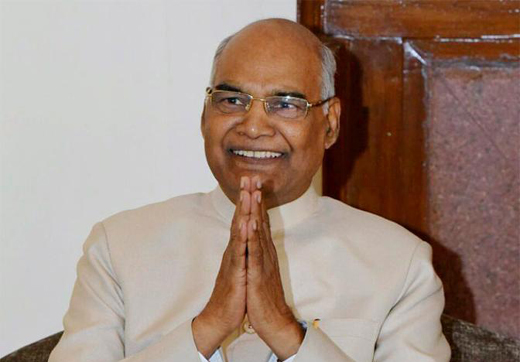
The heavy rain in Delhi on July 20,Thursday morning reminded Ram Nath Kovind of his own humble origins at Paraunkh village in Kanpur (rural). On the day he was elected President, Mr. Kovind remembered how he and his siblings would stick to the corners of their mud hut, as the thatched roof could not stop the rain from pouring into their home.
“My election as President of India is to represent all such Kovinds toiling away to make a living,” he said.
Ever since Mr. Kovind’s nomination had been announced by BJP president Amit Shah, many had expressed surprise about knowing so little about a man who has now become the 14th President. His speech, uncharacteristically emotional, was a nod to a low-profile political career and the journey to the highest office in the country.
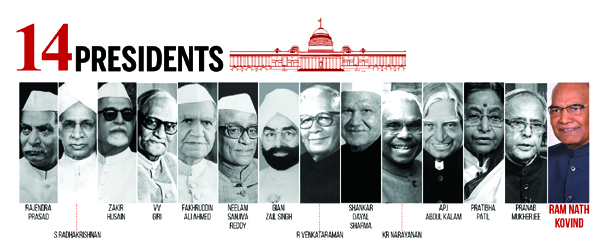
Cleared Civil Services: Mr. Kovind, 71, was born in a village in rural Kanpur, the son of a farmer who subsequently sold off a piece of land to fund his son’s education in Kanpur, where he enrolled for a law degree and prepare for the civil services examination picking up scholarships along the way. Mr. Kovind cleared the exam in his third attempt, but did not join the service that was not of his choice. He chose instead to practise as a lawyer, first at the Delhi High Court and later as standing counsel at the Supreme Court between 1980 and 1993.
He joined the BJP in 1991, and contested two Assembly polls in Uttar Pradesh, both of which he lost. He served two terms in the Rajya Sabha between 1994 and 2002, and served as the president of the Scheduled Caste Morcha of the party between 1998 and 2002, significantly during the period the NDA’s vice-presidential nominee, M. Venkaiah Naidu, was party president. He was appointed Governor of Bihar in 2015 and managed to strike a good working relationship with Chief Minister Nitish Kumar, who reciprocated it by supporting him in the presidential polls despite calls for Opposition’s unity.
For the BJP, which has worked hard to make Mr. Kovind its first person from the party to make it to the Rashtrapati Bhavan, the choice arose precisely from the things that he flagged in his speech – his humble origins, his quiet journey to the higher echelons of the party and left unstated, his representation of the Sangh Parivar’s version of Dalit politics, that of “samajik samrasta” or social harmony within the larger framework of Hindu society. This draws a contrast from Dalit politics of Bahujan Samaj Party (BSP) chief Mayawati, coincidentally on a day when she quit the Rajya Sabha.
“I never dreamed of being President nor held it as a goal for my public life,” Mr. Kovind said, even as he now gets to make the journey from a thatched hut to moving into the Rashtrapati Bhavan.
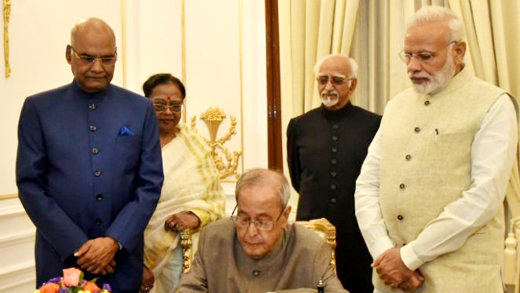
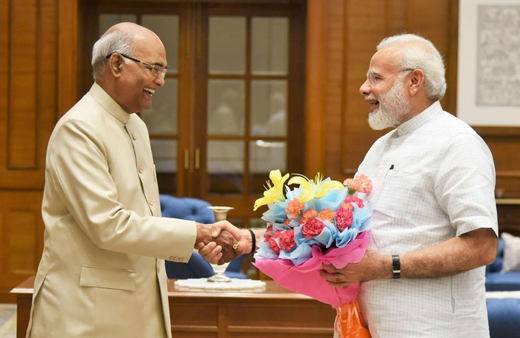
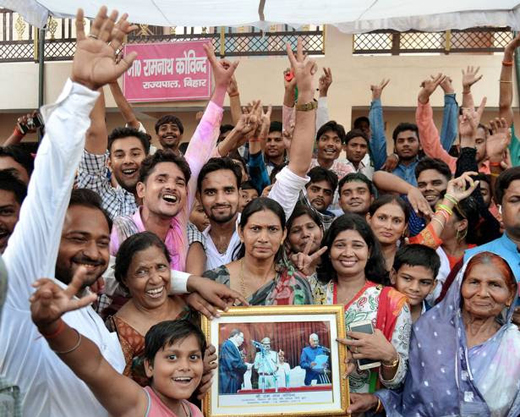
Relatives of Ram Nath Kovind celebrate his victory at Jhinjhak in Kanpur
The new President, Ram Nath Kovind: As India’s 14th President, Ram Nath Kovind will be expected to play the important role of safeguarding the spirit of the Constitution and the foundations of our parliamentary democracy. Unlike his immediate predecessor Pranab Mukherjee, Mr. Kovind moves into Rashtrapati Bhavan after a stint in a Raj Bhavan. Arguably, it is a Raj Bhavan, and not the office of the Vice-President, that is the best preparatory ground for the non-ceremonial duties of the President, particularly those that may involve invoking the office’s discretionary power. After general elections that produced hung Lok Sabhas, former Presidents R. Venkataraman, Shankar Dayal Sharma and K.R. Narayanan adopted different procedures to decide who would have the first shot at forming the government. Venkataraman and Sharma invited the leader of the single largest party, with varying results. While Rajiv Gandhi declined Venkataraman’s invitation in 1989, A.B. Vajpayee accepted Sharma’s invitation in 1996, only to see his government last no more than 13 days. In 1998, Narayanan ascertained the support Mr. Vajpayee had before calling him to form the government. Like these predecessors, Mr. Kovind may be involved in situations with no set precedent. Also, while the use and abuse of Article 356, and the imposition of President’s Rule, are now monitored closely by the higher courts, as President he will necessarily have to use his own discretion should the Union Cabinet send such a recommendation. On contentious pieces of legislation, he can be extremely influential when he counsels caution, using his moral authority and the weight of his public office.
Mr. Kovind secured an impressive victory, receiving more than the number of votes pledged to him, signifying acceptance levels that go beyond the NDA’s political spectrum. Once the names of the candidates for the election were known, much of the interest centred on the support he would garner from Opposition parties not affiliated to the Congress. That he did win substantially more votes vindicates the faith the BJP’s leadership placed on his candidature. To the BJP’s credit, it did not choose a dyed-in-saffron member of the Sangh Parivar. Mr. Kovind’s candidature may have been a strategic political compromise. On the one hand it ensured the wider support that the BJP wanted and, on the other, it wasn’t entirely politically neutral, not enough anyway to allow the Congress or the Left parties the satisfaction of a consensus candidate. He is a Dalit, and his nomination was intended by the BJP to signal a socially inclusive agenda. But as President, Mr. Kovind will have to rise above political and social identities. He will be called upon to apply his mind and distinguish between settled conventions and questionable precedents in arriving at decisions. The office of the President was not conceived as merely a ceremonial post. The discretionary powers that he has demand a delicate balance without slipping into being either an unthinking rubber stamp or an overzealous interventionist.
- Rethinking Drug Seizure Coverage: A Call for Health-Centred Narratives
- Substance abuse - A pressing concern among medical students
- China is winning the trade war without fighting
- Poll promises can become political nightmares
- While India sticks to death by hanging other execution methods vary across the world
- Spiking of drinks, a grave threat for students’ security
- Burden of drugs and substance use among university students in India
- Mangalore medic’s miracle in Bombay 1957
- Needed a national protocol for treatment of substance use disorders
- The Lingering Menace of Drug Abuse Among the Indian Youth—It’s Time for Action
- Need For ‘Students, Alcohol and Drugs’ survey
- New Synthetic Drugs Trapping Youth
- Mood Modifying Chips - Future of Drug Use
- Kashmir Bhavan in Bengaluru: A must visit place
- "MAI and I" Book of Angelic Emotions
- Draupadi Murmu - The New ’President of India’
- Anthony Ashram in the city grows a classic museum
- First College of Fisheries in India - A Golden Jubilarian
- Flushing Meadows - A Vintage Mansion
- The Colonel�s Bequest
- A Mangalorean PM and his RBI Governor Brother: The Extraordinary story of the Benegal Brothers
- There is no higher religion than Truth: Theosophical Society
- L�affaire - Ashu & Yiju of Mangalore
- Mangalore in Kowloon
- 1568 to 2018 AD: 450 years of Christianity in Mangaluru
- Vice President elect Naidu moves on from nadir to zenith, the phenomenal journey
- Embracing the Outdoors: How Heated Jackets Are Revolutionizing Cold Weather Activities
- Efficient and Sustainable Packaging Solutions with FIBCs
- The Hybrid Kilt Revolution | Where Tradition Gets Trendy
- Affordable Elegance | Embrace Style on a Budget with Cheap Kilts
- Unleashing Style and Functionality | Exploring Tactical Kilts
- Mangalore’s Heroic Lady marks 105th Birthday
- Santa the Christmas spirit
- Geriatric care: Mangalore strikes a fine balance
- The Don Who Made Two Empires to Clash
- CHITRAPUR SARASWATS - A Great Kanara Community
- Our new President Ram Nath Kovind’s significant journey to Rashtrapathi Bhavan
- Marriages made in heaven, big fat weddings made in India
- Eid insight - The giver of glad tidings
- CITY INFORMATION
- TRAVEL
- TOURIST INFORMATION
- HEALTH CARE
- MISCELLANEOUS




 Write Comment
Write Comment E-Mail To a Friend
E-Mail To a Friend Facebook
Facebook Twitter
Twitter  Print
Print 

